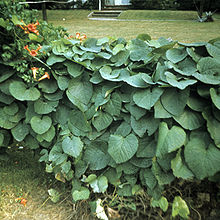Whistle winch
| Whistle winch | ||||||||||||
|---|---|---|---|---|---|---|---|---|---|---|---|---|

Pipe bindweed ( Aristolochia macrophylla ) |
||||||||||||
| Systematics | ||||||||||||
|
||||||||||||
| Scientific name | ||||||||||||
| Aristolochia macrophylla | ||||||||||||
| Lam. |
The pipe winch or American pipe winch ( Aristolochia macrophylla ) is a plant of the genus Aristolochia ( Aristolochia ) in the family of aristolochiaceae (Aristolochiaceae).
features
Aristolochia macrophylla is a strong-growing, left-winding liana and reaches heights of about 10 to 20 meters. The alternate leaves are simply stalked 4 to 6 cm long. The dark green leaf blade is heart-shaped, 7 to 34 inches long and 10 to 35 inches wide.
The flowers stand individually in the leaf axils on a 3 to 7 centimeter long stalk. The hermaphrodite flowers are zygomorphic and threefold. The yellow-green outside and inside brown bloom are fused typical generic and designed Tobacco shaped. There are six stamens . Three carpels are at a 3 to 7 centimeters, with constant ovary grown. The gynostemium is three-lobed. The flowering period extends from late spring to summer.
A six-lobed capsule fruit is formed that is 6 to 8 centimeters long and 4 to 10 centimeters wide. The flat and triangular seeds are about 1 centimeter in size.
The number of chromosomes is 2n = 28.
Occurrence
The whistle wind is found in the mountain forests at altitudes between 50 and 1,300 meters from Pennsylvania to Georgia and west of Minnesota and Kansas in Cumberland and the Blue Ridge Mountains .
ingredients
The pipe binders contain aristolochic acids in leaves, seeds and shoots. It is poisonous in all parts.
Botanical history
The plant was discovered by John Bartram . In 1761 he sent seeds of the plant to Peter Collinson in England . The gardener James Gordon raised plants from the seeds and spread them. In 1783 this plant species was first described as Aristolochia macrophylla by Jean-Baptiste de Lamarck in Encyclopédie Méthodique: Botanique , Volume 1, p. 255. A year later, the same plant species was described again by Charles Louis L'Héritier as Aristolochia sipho ; this name is now considered a synonym .
use
The whistle winch is used as an ornamental plant for greening facades or as a climbing plant on pergolas .
ecology
The leaves of Aristolochia macrophylla are eaten by the caterpillar of the butterfly Battus philenor .
Common names
The following other trivial names are or were used for this type of plant, sometimes only regionally : meerschaum pipes, pipe head bindweed and tobacco pipe bush.
Others
Aristolochia macrophylla has the ability to repair itself in the event of tears in the strengthening tissue ( sclerenchyma ). This ability serves as a model in bionics for a self-repairing protective foam layer for air-filled membranes.
swell
- Kerry Barringer: Aristolochia at the Flora of North America , Volume 3: Aristolochia macrophylla - Online.
- Hermann Göritz : Deciduous and coniferous trees for the garden and landscape . 6th edition. Deutscher Landwirtschaftsverlag Berlin, 1986, ISBN 3-331-00031-0 .
- Bruns plants - product range catalog 2008/09 , DATO-Druck GmbH & Co. KG, Oldenburg
Individual evidence
- ↑ a b c d e Kerry Barringer: Aristolochia at the Flora of North America, Volume 3: Aristolochia macrophylla - Online.
- ^ Erich Oberdorfer : Plant-sociological excursion flora for Germany and neighboring areas . 8th edition. Verlag Eugen Ulmer, Stuttgart 2001, ISBN 3-8001-3131-5 . Page 326.
- ↑ Heinz-Dieter Krausch : Kaiserkron and Peonies red ...: from the discovery and introduction of our garden flowers . Deutscher Taschenbuch Verlag, Munich 2007, ISBN 978-3-423-34412-8 , pp. 40-41 .
- ^ Georg August Pritzel , Carl Jessen : The German folk names of plants. New contribution to the German linguistic treasure. Philipp Cohen, Hannover 1882, page 39, online.
- ^ Veronika Szentpétery: Clever materials cement themselves. In: Telepolis. February 28, 2006, accessed June 13, 2011 .


